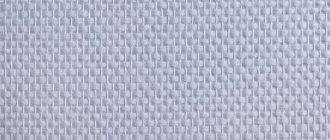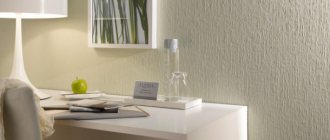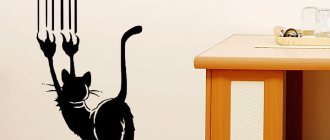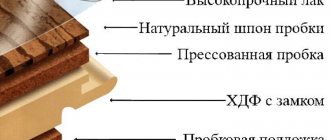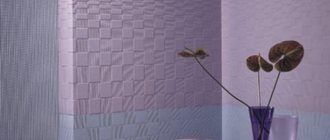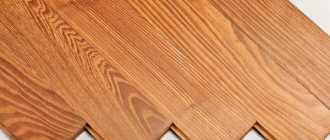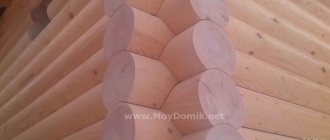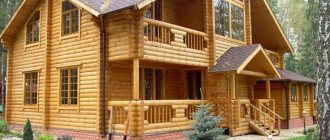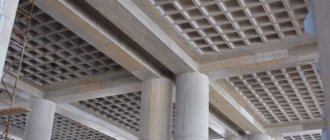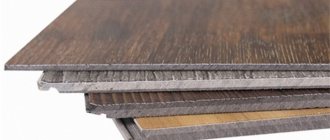10/14/2018 Painting walls is one of the most effective and simple methods of interior decoration. Modern paints allow you to give the room an aesthetic appearance, make it rich and beautiful. Painted walls, unlike wallpaper, look monolithic and have no seams. Finished surfaces are easy to clean, do not absorb odors, provide a long service life and allow you to update the interior with a simple repainting.
Before carrying out this kind of repair, the walls must be prepared. If the old plaster is weak, or there are significant defects on the surface in the form of broken areas or large irregularities, then preliminary plastering is indispensable. But when it comes to relatively smooth walls or ceilings with minor defects, you can get by with less labor-intensive preparation. For this purpose, special types of rolled covering materials are used: glass wallpaper or paintable wallpaper on a non-woven basis. For many, choosing one material or another can be difficult. Which is better? Let’s try to figure it out in this article.
What about moisture resistance?
The non-woven base consists of cellulose, which is known to swell upon contact with water.
Therefore, they cannot be used in all rooms of the house. Non-woven fabric is suitable for living rooms, bedrooms, offices - rooms with dry air. An exception is paintable wallpaper coated with moisture-resistant paint. The application of paintwork creates a protective layer on the surface that provides protection from moisture. There are also moisture-resistant rolls that eliminate the need for painting - but even these should not be used in the bathroom or close proximity to water.
Vinyl wallpaper is covered with polyvinyl chloride, which ensures the absence of hygroscopicity and moisture permeability - water simply will not get onto the non-woven base. Suitable for finishing in the hallway, kitchen and bathroom. Thanks to the peculiarities of hot stamping technology, the surface is washable - even with a brush it is not afraid of cleaning.
Polyvinyl chloride gives a significant advantage to wallpaper, allowing it to be used in damp and even wet areas.
Glass wallpaper
Similar in properties to structural wallpaper are glass wallpaper, which is made from interwoven fiberglass. Thanks to the interlacing of threads, a three-dimensional pattern and relief is created. The fiberglass layer can either be applied to a paper or non-woven base, or directly glued to the wall.
The advantages of this wallpaper compared to structural wallpaper include even greater strength, as well as the ability to smooth the surface on which they are glued. In some cases, they can even cover small cracks and potholes. Paint is applied on top. Glass wallpaper is more fireproof compared to other types of wallpaper.
Article on the topic
Gender question: what to choose, parquet or laminate?
The downside is the high cost. Therefore, glass wallpaper is mainly used on an industrial scale - for the decoration of large hotels, office and shopping centers, hospitals and other institutions.
What wallpaper is wear-resistant?
Remaking repairs every 2-3 years negatively affects not only the condition of the wallet, but also the nervous system. In addition, it takes a lot of time and effort. To glue wallpaper less often, choose options with the longest service life.
Strength is determined primarily by resistance to mechanical stress and abrasion, but service life is also affected by light fastness.
Non-woven wallpaper is a little more reliable than paper wallpaper: but in places of high load (corridor, kitchen) they quickly become unusable. The degree of UV protection varies from model to model, but since... Wallpaper for walls made of this material is usually light-colored and is not in danger of fading.
Vinyl wallpaper, especially those produced using hot stamping technology, is not afraid of almost anything: in fact, this type of wallpaper can be called plastic. They do not wear off due to contact with furniture or constant touching, and dirt can be cleaned with clean water or detergent. The colors of vinyl are brighter, the designs are more interesting - and at the same time, it is not at all afraid of the sun.
For the kitchen and bathroom, there is the so-called “kitchen vinyl” - such wallpaper differs from ordinary wallpaper in an additional rubberized layer that resists the ingress of water and facilitates easy cleaning.
If the operating conditions are observed (no mechanical loads, high humidity), the non-woven fabric will last up to 8 years. High-quality vinyl sheets are characterized by increased durability and retain their original appearance for up to 20 years.
How to choose fiberglass?
To purchase high-quality material that will meet all the characteristics mentioned above, you need to choose products from well-known manufacturers.
It is best to purchase high-quality fiberglass “spider web” from famous world brands
In the Russian building materials market, products from manufacturers from Holland – “Spektrum”, Finland – “Wellton”, and Sweden – “Oscar” and “Samtex” have gained popularity. Of the domestic manufacturers, the technology for manufacturing fiberglass, in full compliance with international standards, has been well mastered. It should be noted that almost all companies producing fiberglass, in addition to them, produce fiberglass wallpaper, as well as adhesive compositions for them - these products are sold under the general brand of the company. It is advisable to use canvas and glue of the same brand - they are completely adapted to each other.
In conclusion, I would like to remind you that painting fiberglass “gossamer” is primarily intended for reinforcing the walls and ceilings of rooms and protecting them from the expansion of small cracks that have appeared, as well as from the appearance of new ones. The second function that this material is designed to perform is leveling surfaces. However, many homeowners also prefer to preserve the structure of fiberglass, without covering it with putty, and using it as a decorative material. Thus, the “web” acquired a third function.
One cannot but agree that this multifunctional material helps solve many problems and save money allocated for interior decoration. Therefore, for many owners it can become a real salvation when carrying out any repairs - both cosmetic and major.
And at the end of the publication, traditionally, there is a video on the topic. This time, a professional finisher will share his experience of gluing fiberglass “cobwebs”.
Which wallpaper is heavier?
It is unlikely that this factor will be decisive when choosing a material, but it cannot be ignored. Because heavy weight can be a disadvantage when ordering repair products online and arranging for long-distance transportation.
Although non-woven ones differ in composition from paper ones, they still weigh a little: the average weight of a wide 10-meter roll is ~2 kg. This equates to a narrow 10 meter roll of hot stamped vinyl. Its weight is ~1.7 kg.
This fact determines the use of a special adhesive composition for vinyl wallpaper - it must be viscous in order to hold heavy canvases.
Compound
In the production of non-woven material, artificial fibers are used. The main composition of the interlining fabric is viscose. Since the material is non-woven, it does not have a transverse or longitudinal thread, however, craftswomen prefer to cut the reinforcing fabric lengthwise, since it stretches slightly in the transverse direction. According to GOST, adhesive interlining fabrics are marked like other fabrics. That is, the manufacturer must indicate the composition and care rules.
The paper-like substance is considered semi-synthetic. That is, cellulose fibers are diluted with polyester. However, 100% viscose varieties are also available on sale. By chemically modifying the fibers, it is possible to increase strength and wear resistance. Rigid modifications are characterized by high dimensional stability, are well painted and retain color, and are resistant to dirt.
Which ones are more environmentally friendly?
To figure out which finishing material is less dangerous, you should analyze the composition of each.
Non-woven wallpaper
They are considered a practical analogue of paper wallpaper. Made from a mixture of natural (cellulose) and synthetic (polyester) fibers. At the same time, synthetics are environmentally friendly, do not emit harmful substances and are even suitable for use in children's rooms.
In fact, all the advantages of paper-based material are preserved: wallpaper allows steam to pass through, breathes, and does not emit harmful substances. But at the same time they are resistant to moisture and have high strength.
Vinyl wallpapers
Depending on the type, the base is made of cellulose (paper) or a mixture of cellulose and polyester (non-woven). The main difference from non-woven fabric is the composition of the top layer: in vinyl it is polyvinyl chloride. Moreover, vinyl can be foamed or hot-stamped (includes silk-screen printing - sealing silk threads under the film using high temperature).
The danger comes from PVC: if an unscrupulous manufacturer saves money, the canvas can emit caustic volatile substances - including the dangerous compound vinyl chloride.
Another disadvantage is that vinyl wall coverings do not allow air to pass through, which can cause mold and mildew to form. To avoid this, be sure to prime the walls and use glue for vinyl wallpaper - it also contains antiseptic additives.
The above does not apply to evaporated vinyl - thanks to a special process, harmful substances are removed from it during production and the coating becomes absolutely safe. True, such a roll costs 1.5-2 times more than a regular one.
Non-woven fabric is more environmentally friendly and safer for health. Even high-quality PVC wallpaper should not be used in children's rooms and bedrooms.
Features of non-woven fabrics
Non-woven wallpapers are no less in demand than vinyl ones. This is facilitated by their presentable appearance and high performance properties. We suggest evaluating the advantages and disadvantages of this variety to make it easier to make a choice in favor of a certain type of finishing material.
Advantages and disadvantages
The main advantages of non-woven fabrics include:
- Elasticity and reliability, maintaining integrity under tensile loads, which makes it possible to use them when decorating walls in new buildings without damaging the integrity after shrinkage of the building;
- Preservation of integrity when decorating walls in a room operated in conditions of high humidity. After air drying, the appearance of the decorative coating does not change. This makes it possible to use it to decorate walls in any room;
- Environmental friendliness. In the manufacture of non-woven wallpaper, cellulose fibers are used, due to which the material is considered safe and has good air permeability. The material can be used to decorate bedrooms and children's rooms;
- Fire safety;
- A relief front surface that improves the appearance of the lined surface and allows you to level out any unevenness and cracks on the base;
- Easy to install, requiring application of adhesive only to the wall. At the same time, the canvas itself has quite a lot of weight, which must be taken into account;
- Can be used for gluing various types of bases;
- Long service life;
- Availability of washable models that allow wet cleaning during operation;
- High quality top layer.
The disadvantages of non-woven fabric include:
- note the high cost of finishing materials;
- difficulty in painting due to increased consumption of paints and varnishes;
- inability to clean individual models;
- impossibility of decorating existing ones based on inscriptions and other color variations. Old paint and inscriptions clearly show through the decorative coating, which places increased demands on the quality of base preparation.
The embossed outer layer is sometimes considered a coating disadvantage. It is easy to damage. In addition, dust constantly accumulates in existing cavities, causing additional dry cleaning.
Kinds
Non-woven wallpaper can be:
- Smooth. Subsequent painting in the desired color is possible. Single-layer canvases. They consist only of non-woven fabric. To make the coating, different types of cellulose sheets are used: unmodified and modified, glued and not. The production technology used determines the density and thickness of the layer;
- Foamed. They are two-layer. Production is carried out at a fairly high temperature, due to which pores are formed in the heated vinyl, creating a foaming effect. The technology allows the formation of various patterns on the canvas;
- Embossed. Multilayer material, including several layers. To form structural patterns, layers of non-woven fabric are used. Often the latter is the basis. Manufacturers offer canvases with various types of designs. Particularly popular are models that imitate natural materials;
- For painting. A popular type of non-woven fabric. Widely used for office decoration. High strength and elasticity of the coating significantly increases the service life of the decorative coating. If necessary, it allows you to update the appearance by painting again. Manufacturers offer canvases with small textured patterns. No need to adjust the pattern.
Attention! When choosing paint for painting pasted wallpaper, be sure to take into account the conditions of future use.
Where is the best place to glue?
The characteristics of non-woven wallpaper significantly expand their possible range of use. They can be safely used to decorate a bedroom, if you give preference to textile models with a suitable color. The color of the canvas should not be bright. If desired, you can focus on a certain wall, for example, located behind the head of the bed. In this case, the bright insert will be out of constant visibility and will not cause irritation.
For the living room, designer products with vinyl coating are a good option. Using canvases of different colors, you can zone the space. The collections offered by manufacturers allow us to turn the most daring decisions into reality. Especially effective are multi-layer models that can be painted and have a deep texture.
For a children's room, non-woven wallpaper is also a suitable option. Unusual designs and bright colors are preferred. It is worth using high-density fabric.
This type of finishing material is also suitable for the kitchen. To do this, you should choose washable fabrics. To decorate with them, you should choose an area near the dining table. To decorate the apron, it is preferable to use tiles.
Features of gluing and removal
To cover walls with non-woven wallpaper, you need to properly prepare the wall. To do this, you need to remove the old decorative coating from the wall, carefully level the surface, and remove dust. Further installation work is performed in the following sequence:
- The adhesive composition is being prepared. You should use a mixture designed specifically for non-woven wallpaper. When preparing the mixture, you should follow the manufacturer's recommendations. As a rule, the mixture should be kept for 15 to 30 minutes before use;
- Wallpaper is being prepared. Strips are cut to the required length. The presence of a drawing must be taken into account. If necessary, adjustments are made. If this is not required, the stripes are made 5 cm longer at the bottom and top;
- The wall is generously lubricated with adhesive. The excess amount is squeezed out to the edges of the strips. There should be enough glue. If there is a shortage, the strip will not be fixed on the wall surface;
- Glue the strip, securely fixing the wallpaper to the wall surface. To do this, it is carefully smoothed, removing excess glue and air bubbles. Pasting the walls begins from the corner near the window;
- Cut off excess material at the top and bottom. The glue protruding from under the wallpaper is removed with a rag and sponge. This should be done with extreme caution.
Dismantling of the non-woven covering is carried out taking into account its main features. In its main characteristics, non-woven fabric is significantly superior to paper. During the dismantling process, the canvases are removed entirely. For removal, use spatulas of suitable size. Perforating the surface to provide access to the underlying layers increases the efficiency of the process.
Examples in design
Non-woven wallpaper is actively used in interior design. We offer you to look at examples of ready-made solutions that can be used as an idea.
Which ones have more design options?
When choosing between vinyl and non-woven, you should pay attention not only to the service life and smoothing out wall unevenness, but also to the appearance. After all, in the end, coloring affects the final result of finishing work.
Non-woven fabrics are not distinguished by a variety of design finds. Most of the canvases are plain and smooth. A relief structure is achieved using foaming, but working with such a texture is not very convenient. But the drawings turn out to be deep: after all, they are not applied to the surface, but are obtained as a result of mixing colored fibers.
Vinyl wallpaper, due to the manufacturing method, is considered more diverse. They can be covered with ornaments, have a relief on the surface or imitate various textures (leather, wood, brick, concrete). The color palette is also extensive: from monochrome or pastel to bright, deep, rich shades.
Of the two options (vinyl or non-woven), the first has more possible design options.
How to visually and tactfully distinguish one from the other
To see the difference between the canvases, it is recommended to take a closer look and take into account the following criteria:
- vinyl is thicker and consists of several layers;
- in vinyl sheets, embossing appears on the reverse side (the interlining on the reverse is smooth and pleasant to the touch);
- non-woven fabric is more textured and soft, and if you touch the vinyl you can feel the coolness.
If you have difficulty making a choice when purchasing, it is better to contact a specialist for help. You should also pay attention to the rolls. Each roll has a label indicating the type of material.
Paper wallpapers are very popular
How they differ: comparison table of characteristics
The summary table will demonstrate the difference between vinyl wallpaper and non-woven wallpaper:
| Non-woven | Vinyl | |
| Moisture resistance | Low stability | Waterproof coating |
| Hygroscopicity | Breathe, maintain a good microclimate | Do not allow air to pass through, fungus may form |
| Duration of service | Up to 10 years | Up to 20 years |
| Weight | Heavier than paper, but light | Heavy but durable |
| Environmental friendliness | Safe for children and adults | May release chemicals |
| Sticking | Does not cause difficulties with certain skills | Does not cause difficulties with certain skills |
| Difficulty of care | Almost impossible to clean | Washable, you can use cleaning products |
| Design | Limited color range and applied pattern | Virtually no restrictions |
| Masking unevenness | Dense foam types erase small wall defects | High quality hides imperfections |
No material is perfect: vinyl sheets last a long time, but are not suitable for bedrooms and children's rooms. Non-woven ones are not very dense, but they are absolutely safe. Which one to choose depends on the place of use, budget for repairs and many other factors.
Feedback on application and subsequent coloring
According to experienced users, the base must be prepared before gluing the repair interlining. The surface must be dry, as strong as possible and free from dirt and dust. Existing chips and uneven areas should be filled with puttying compound. As buyers emphasize, glue must be applied to the prepared surface using a roller. The composition can be intended for non-woven wallpaper. All subsequent canvases are fitted end-to-end. Repair non-woven fabric can be painted with water-based acrylic or latex paint using a spray bottle. Or you can use a fluffy roller, with which two layers are applied. If you plan to use a dark color, then repainting is not recommended more than 3 times. If you purchased a light-colored color, then repainting can be done 7 times or more.
As practice shows, when using construction non-woven fabric, the room remains absolutely clean, which is no different from putty work, which is accompanied by the formation of a huge amount of dust and dirt.
The painting non-woven fabric has fluffed up
The craftsmen glued non-textured smooth painting non-woven fabric (good 150g), then painted the walls with a spray gun 2 times (without intervals). As a result, the interlining fluffed up in some places. If you ran your hand over the surface, it became very rough, and in these places coils appeared (emphasis on a) and the paint was darker, we tried to wipe them off with our hand, it seemed to be erased. Everything looks terrible. I don’t know if they can erase everything (the whole kitchen), and even the paint at the joints of the non-woven fabric is different in color (where the seams were puttied). What did my masters do wrong, please tell me? I still have to paint the room with the corridor.
